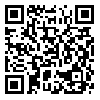Volume 15, Issue 4 (Winter 2008)
J Birjand Univ Med Sci. 2008, 15(4): 38-48 |
Back to browse issues page
Download citation:
BibTeX | RIS | EndNote | Medlars | ProCite | Reference Manager | RefWorks
Send citation to:



BibTeX | RIS | EndNote | Medlars | ProCite | Reference Manager | RefWorks
Send citation to:
Sadeghnezhad F, Niknami S, Ghaffari M. Effect of health education methods on promoting breast self examination (BSE). Journals of Birjand University of Medical Sciences 2008; 15 (4) :38-48
URL: http://journal.bums.ac.ir/article-1-375-en.html
URL: http://journal.bums.ac.ir/article-1-375-en.html
1- Associate Professor, Department of Health Education, Faculty of Medical Sciences, Tarbiat Modarres University, Tehran, Iran , niknami6@yahoo.com
Abstract: (20375 Views)
Background and Aim: Breast cancer is the most prevalent cancer among women, because one out of every seven women is prone to develop breast cancer. Early diagnosis of the disease has an effective role in its treatment. One of the screening methods is Breast Self-Examination (BSE). If this simple method is taught to women, they can diagnose malignant tumors in their breasts in 90 percent of cases and receive due treatment. This study was done to investigate the effects of various educational methods on knowledge, attitude, and practice of women regarding BSE and compare these effects. Materials and Methods: In this quasi-experimental study 90 ladies over 40 years referring to Tehran Shahid Kalantari clinic were divided into three equal groups. One group (30 women) was taken as the control group and the other two as the cases. The following educational methods were applied to the two case groups respectively: A group discussion method, B. eclectic method (i.e. films, lectures, face-to-face-instruction, etc.). Data collection tools were a questionnaire consisting of demographic queries, KAP (knowledge, attitude, and practice) questions and a check-list for visible BSE performing on the part of the cases. The obtained data was analysed by means of the statistical software of SPSS, using parametrical statistical tests (i.e. one-way variance analysis, paired-t) and non-parametrical tests (W., C., and 2) and P≤0.05 was taken as the significant level. Results: This research indicated that education by means of both methods raises the level of knowledge, attitude and practice in ladies regarding BSE (P<0.0001). Besides analysis of variances showed that KAP level had a significant difference compared with that of the control group (P<0.0001) .Correlation test showed no significant difference between demographic characteristics on one side and level of KAP on the other. Conclusion: Considering the findings about the effect of instruction on KAP of women with respect to BSE, using any of available facilities such as individual or group education as well as audio- visual methods in health care centers would be advantageous.
Type of Study: Original Article |
Subject:
Health Education
Received: 2009/05/12 | Accepted: 2016/03/10 | ePublished: 2016/03/10
Received: 2009/05/12 | Accepted: 2016/03/10 | ePublished: 2016/03/10
Send email to the article author
| Rights and permissions | |
 |
This work is licensed under a Creative Commons Attribution-NonCommercial 4.0 International License. |





